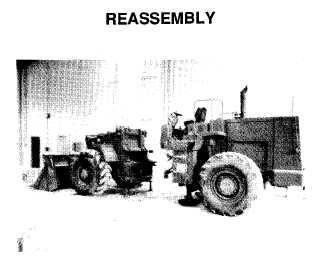TM 5-3805-258-10
38
39.
Be sure set screw slot is alined with the “V” mark
cut into the edge of the skid support. Tighten set
screws in skid supports under rear frame and tighten
jam nuts to prevent the skid support jack screws
from loosening during transport.
Store all tools and loose parts in the storage bin on
the platform and in the compartment behind the
seat. Strap down all loose ends of hoses and wire
harnesses.
2. To steer, depress the right brake pedal and move the
steering lock switch in the direction you want to turn.
After each steering maneuver, release the brake pedal
slightly before releasing the steering lock switch. With
the steering lock switch in the center position, the
brakes function normally.
3. See page 77 to locate all lifting and tie down eyes for ground
and air transport and slinging from a helicopter.
WARNING
No personnel shall be in hitch area when engine
is running.
Chain the boom and bucket to the front frame to
40.
ensure safe transport in the event of a hydraulic
hose failure on the front section.
DRIVING
The rear section can now be driven to a convenient site for
helicopter transport. Driving is essentially the same as for
a complete machine, except the steering wheel is inopera-
tive. Instead, each rear wheel is individually braked to
turn the rear section.
1.
Start the engine and allow the air pressure to build up.
1.
Start the engine and maneuver the rear section within
Shift the transmission to a speed that will allow moving
two to three feet of the front section. Approach the
the rear section and accelerate the engine.
front section in as straight a line as possible.
CAUTION
While holding the brakes on, do not rapidly oper-
ate the steering lock switch back and forth. The
master cylinder will reach its stroke limit and a
warning light and buzzer will actuate.
2. Position jacks under the tie-down eyes at the rear of
the front frame and snug the jacks.
9
2








